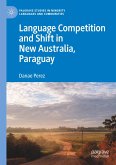Rajend Mesthrie examines the rise of a new variety of English among Indian migrant workers indentured on the plantations of Natal in South Africa.
Rajend Mesthrie examines the rise of a new variety of English among Indian migrant workers indentured on the plantations of Natal in South Africa. Considering the historical background to, and linguistic consequences of, language shift in an immigrant context, he draws significant parallels between second language acquisition and the processes of pidginization and creolization. In particular, he analyses universals of second language acquisition and the role of transfer from the Indic and Dravidian substrate languages. English in Language Shift observes the acquisition of language in its social setting, often outside the classroom. Its linguistic focus is on the distinctive syntax of South African Indian English, with respect to word order and clause structures; and it contains descriptions of lexis, phonetics and morphology, in terms of social variation. South African Indian English is compared with other dialects within South Africa, with English in India, and with Englishes generally.
Review quote:
'A fascinating and very well-documented account of the evolution and development of South African Indian English since the Indian indentured labourers were brought into South Africa, beginning in the 1860s.' Gillian Sankoff, University of Pennsylvania
'A most impressive piece of work.' J. M. Coetzee
Table of contents:
Preface; Acknowledgements; 1. Historical background: the shaping of a New English; 2. Variation in SAIE: a first glimpse; 3. Syntactic variation: the relative clause; 4. Word-order principles; 5. Non-syntactic variation; 6. Perspectives from second-language acquisition; 7. Perspectives from pidgin and creole studies; Appendices; Notes; Sources and references; Index.
Rajend Mesthrie examines the rise of a new variety of English among Indian migrant workers indentured on the plantations of Natal in South Africa. Considering the historical background to, and linguistic consequences of, language shift in an immigrant context, he draws significant parallels between second language acquisition and the processes of pidginization and creolization. In particular, he analyses universals of second language acquisition and the role of transfer from the Indic and Dravidian substrate languages. English in Language Shift observes the acquisition of language in its social setting, often outside the classroom. Its linguistic focus is on the distinctive syntax of South African Indian English, with respect to word order and clause structures; and it contains descriptions of lexis, phonetics and morphology, in terms of social variation. South African Indian English is compared with other dialects within South Africa, with English in India, and with Englishes generally.
Review quote:
'A fascinating and very well-documented account of the evolution and development of South African Indian English since the Indian indentured labourers were brought into South Africa, beginning in the 1860s.' Gillian Sankoff, University of Pennsylvania
'A most impressive piece of work.' J. M. Coetzee
Table of contents:
Preface; Acknowledgements; 1. Historical background: the shaping of a New English; 2. Variation in SAIE: a first glimpse; 3. Syntactic variation: the relative clause; 4. Word-order principles; 5. Non-syntactic variation; 6. Perspectives from second-language acquisition; 7. Perspectives from pidgin and creole studies; Appendices; Notes; Sources and references; Index.








